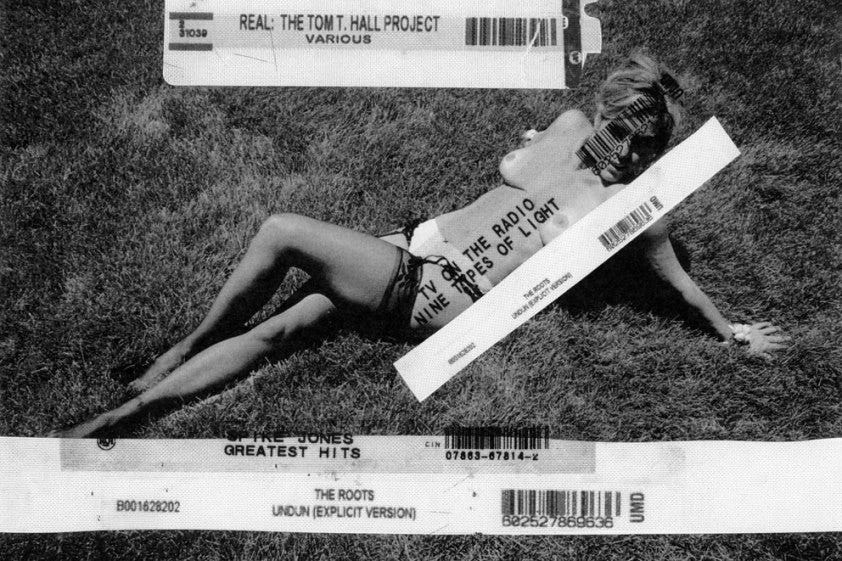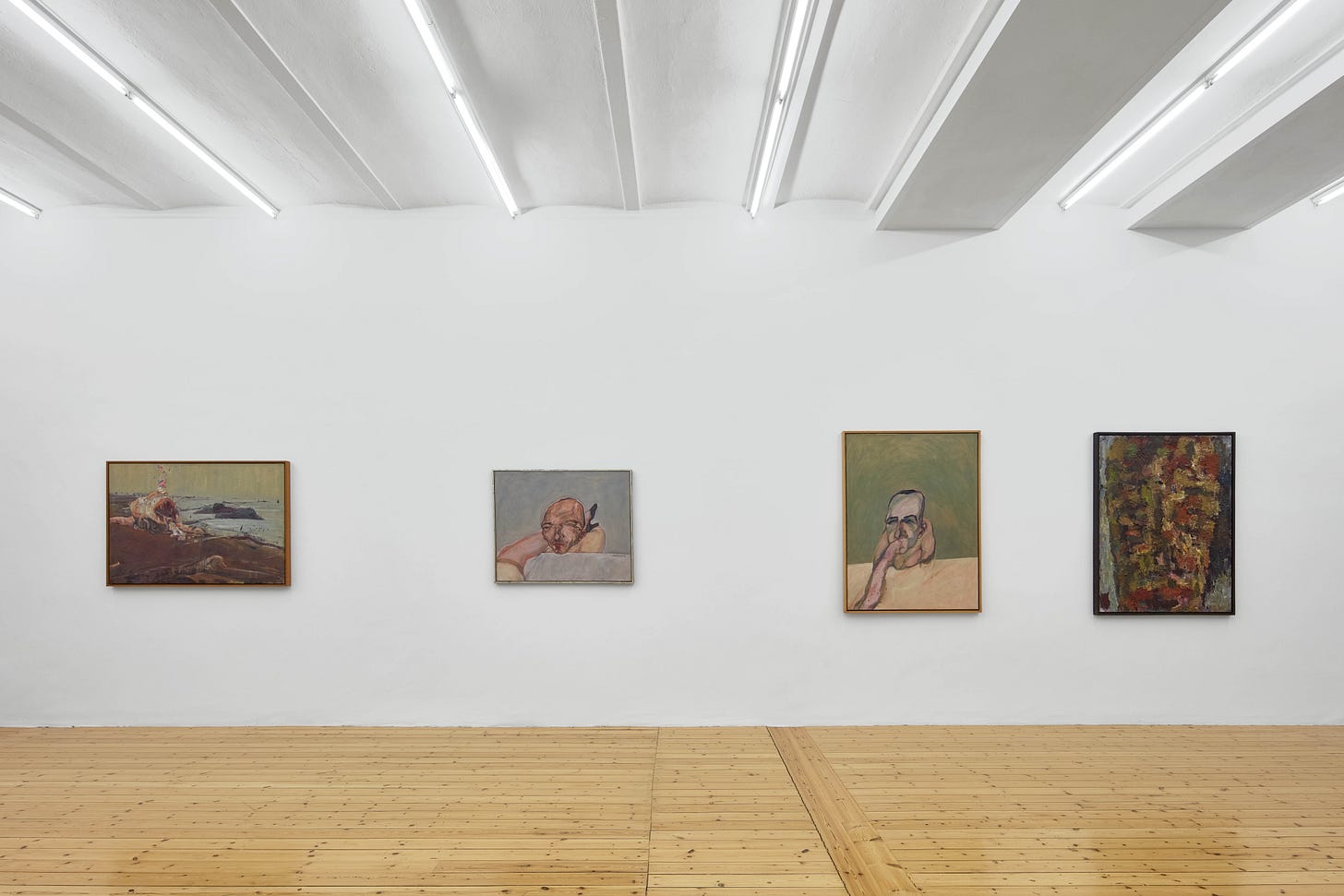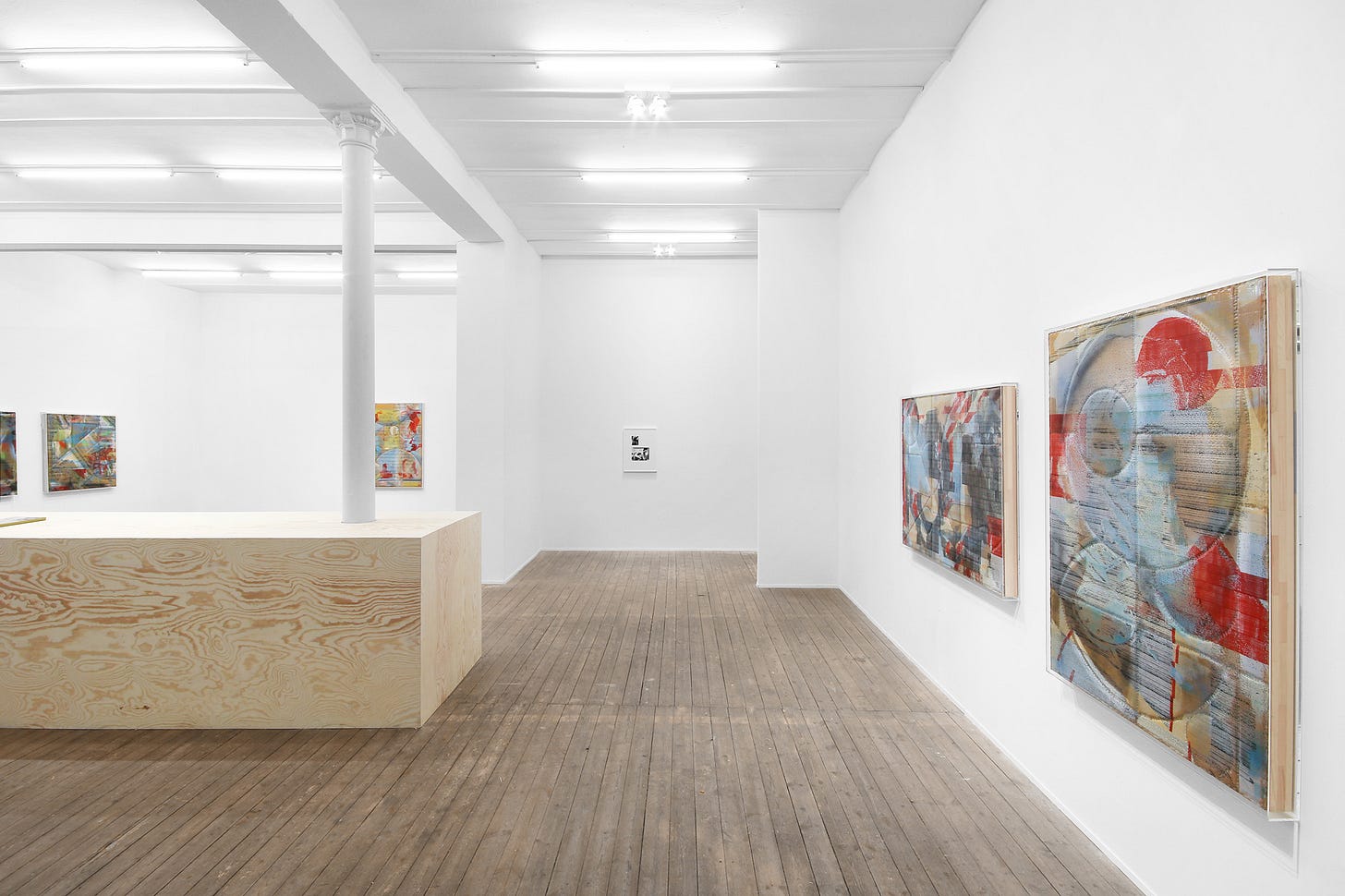Gallery Walk in Hamburg: Playboy Bunnies, Dizzy Portraits & Hugh Grant
Eventhough the main reason for my pilgrimage to Hamburg was the UNESCO World Heritage site Penny an der Reeperbahn (my German readers know what's up), I got to check out a few galleries in town.
MARWAN. Works from 1964-2008
The exhibition spans the Syrian-German artist Marwan Kassab-Bachi’s (1934-2016) whole career going from figuration to abstraction. Marwan’s earlier work is uncanny: A male figure set against a dirty grey background towers over a girl or young woman in a yellow dress, hugging her waist from behind. His inflated head and the physical overpowering remind me of Paula Rego’s (1956-2022, British-Portuguese) disturbing paintings of suggested violence.
A male head leans over an edge. A leg rests on one shoulder. The black high heel and stockings suggest a sexual scene, the resigned expression on the man’s face doesn’t. In another painting, the head is looking away while holding something fleshy in its mouth (just enough abstraction to make me doubt whether it’s a dick). The pasty texture of the heads has something of Francis Bacon (1909-1992, British).
Later in the 70s, Marwan focused on portraits. He isolated the close-up face first horizontally and dissolved its features in vibrant strokes of watercolor until it lost almost all resemblance to a human form. He finally ended up framing these heads vertically, painting the same face over and over again, layering paint like the sitter’s character traits.
until March 27, 2024, Sfeir-Semler Gallery, Admiralitätstrasse 71, 20459, Hamburg
Christoph Blawert: 27 Hochzeiten & ein Todesfall
Christoph (Millenial, German) had some fun with the title jokingly refering to Hugh Grant’s beloved Brit rom-com Four Weddings and a Funeral (1994). The gallery is filled with 27 small postcard-format paintings. They play with Impressionism, a painting style that dominated French art in the second half of the 19th century: Artists painted outside instead of the studio, and they painted what their eye caught in a glimpse, not the perfect correct scene. Chris said, don’t mind me if I do…

So you might ask: if innovation is a criterion for good art, and Chrissy does what the Impressionists did in the 19th century, same motives, same colors, same techniques, what makes his work special? That’s a good question, let’s see… I think that Christoph is an inherent optimist. A romantic even. To just travel France with a camera, some painting tools, and always ready for a cute lil picnic is just so, so coquette. It’s as if he became a time traveler foolishly romanticizing a long gone artist lifestyle. I think I like this little life…
Behind a corner, there’s an easter egg wall. Well, the funeral of the title seems to play a role here: A huge two-panel painting of a woman lying in the bushes, lit aglow by an oldtimer car approaching from behind. It’s actually the cover of a book that Christoph repainted, the book sitting on that shelf.

In between lighters, a cardboard mask with Chris’ face on it, some vinyl, and more postcards, I spotted a QR code: It leads to IM GLOTTERTAL (2020) a 14-minute movie starring Christoph: Two guys play tennis, briefly abandon the court looking for the ball, lay down in the grass and end up sharing cherries and a cigarette. The vignette effect suggests a spy observing the scene through binoculars. I have absolutely no idea how this relates to the cute postcard paintings in the room before, but go for it, Chris.
until March 28, 2024, Produzentengalerie, Admiralitätstrasse 71, 20459, Hamburg
Thomas Baldischwyler: Aktuelle Arbeiten (An den Rand der Zukunft denken)
Thomas (Gen X, German) makes objects that first look like glossy paintings. Then they look like brocade fabric. But they are cardboard. How the turns have tabled. Thomas developed a unique technique for his work. Similarly to silk-screen printing, he applies all colors separately. It’s similar to the barcodes on groceries. He staples the colorfully printed cardboard, making it look even more like padded textiles and finally frames it in acrylic glass. The word Mirror is written on Untitled (RAND 1) (2023-2024), inverted and upside down.
There are some smaller collaged works. Thomas layers magazine spreads, non-sense placeholder texts, comics, and drawings. The mirror pops up again in Untitled (Seite 58) (2021-2023): A poorly cut-out snippet from the Hamburg-based Spiegel [Mirror] Magazine. The headline mentions the rich. A repetition of the same speech bubbles over and over again: Den Teufel tue ich! / Es ist der Spiegel, nicht wahr? So hast du es gemacht. [The hell I will! / It's the mirror, isn't it? That's how you did it.] A snippet with Uranus, Neptun, and Pluto, their labels written correctly and inverted. Stamps from the Hamburg University peak out from underneath. I feel like this calls for a quote from legendary poet Robert Alexander III, aka Moose from Step Up: “Well, I think the question you gotta ask here is, ‘Why NOT […]?’”
until March 30, 2024, Galerie Conradi, Admiralitätstrasse 71, 20459, Hamburg
Josef Bauer
Every day after clocking out of his 9 to 5 as a civil servant, Josef (1934-2022, Austrian) used to make art. The art world slept on him for quite a while, but galleries and museums are getting back to appreciating his work.
In the 60s, Josef worked with concrete poetry, the idea that letters and sounds can be just as interesting and full of meaning as the words they make up. Knittertext TAR (1969) is made up of the three title-giving framed paper letters. He made the flat shapes physical by crunching and pressing them back between the glass.
A series of works plays with painting and sculpture. Josef drew inspiration from Franz Erhard Walter’s (*1939, German) wearable sculptures. He sourced fashion magazines and historical images and added a thick, colorful, vertical brushstroke on top of the chosen subject. It’s as if the models on paper carry the acrylic paint like an object on them.
until March 30, 2024, Karin Guenther, Admiralitätstrasse 71, 20459, Hamburg
Richard Prince
Richie (Baby Boomer, American) was one of them audacious guys of the new Appropriation Art era. He became famous for enlarging and reprinting the cowboy photographs of Marlboro ads. And best believe everybody ate that up. The works in the gallery are his more recent photographs.
He brought a retired Playboy Bunny in front of the camera and portrayed her in black and white as she sensually poses in pools and next to cars. Sometimes nude, sometimes only in stockings, sometimes in an oversized white Tee. He then added barcode stickers of CDs and music he likes. Richie layers two sides of entertainment and commerce. An interesting comparison, music and erotic modeling. As a consumer, you own none of it, neither the bands, nor the physical bodies of the women posing, but you get to enjoy both as far as you’re allowed.

no date yet, Jürgen Becker Galerie, Admiralitätstrasse 71, 20459, Hamburg
If you want to stay updated on exhibits in Hamburg, I recommend subscribing to the Kunstflâneur Newsletter.
So, what do we think of the art scene in Hamburg? I mean, I was lucky that all these galleries were in the same building, but still… Like, comment, and share as always. Luv u!
See you soon!!!
Jennifer
The Gen Z Art Critic








